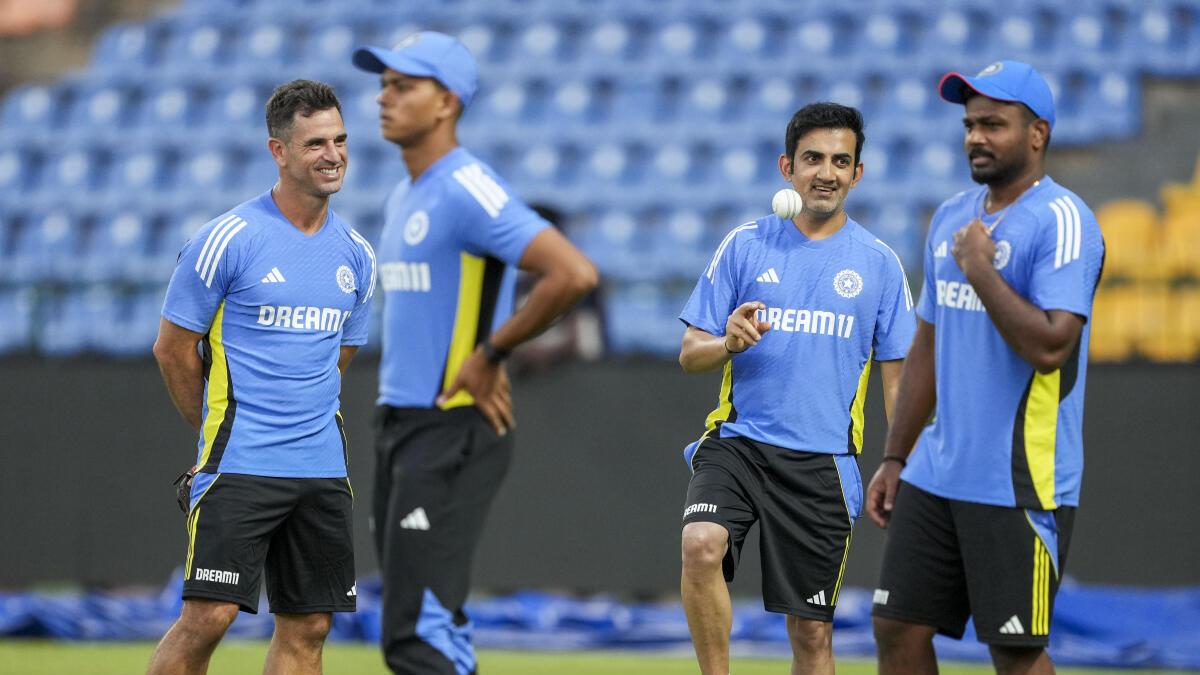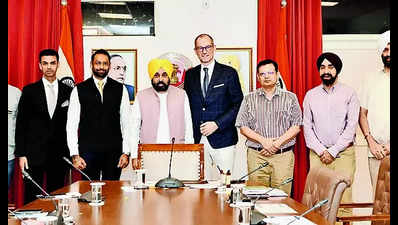Strange, but true: India’s World Cup-winning squad of 1983 had precisely one individual for support. P.R.
Man Singh beat back the challenge of Niranjan Shah through an election to earn the right to be the team manager, rounding off the contingent of 15 that would officially represent the country at the last of the 60-over World Cups. Single-handedly, Man Singh had to manage travel and training arrangements, dole out allowances, ensure that all official commitments were honoured, facilitate the immediate treatment of injured players, the works..

. Get it, right? The mushrooming of the cricketing ecosystem has brought us to such a pass that today, on average, there is one member of the support staff for each player in the squad. That’s no longer an excess; with cricket leaving behind its amateur days and stepping into a bold, new professional world where there is no place for excuses or laggards, this has become a necessity, not a luxury.
INTERVIEW | India needs to do well in the first three matches in Paris: Herman Kruis To each their own Cricket head coaches, like their counterparts in other team sports, tend to bring their own coaching staff when they take charge. More than anything else, it’s because they know what these individuals bring to the table, they trust them implicitly and they know that everyone is on the same page, pulling in the same direction. It’s not that they don’t have confidence in the existing personnel; a fresh start is sometimes not just welcome but imperative because in today’s world, remaining static is often a retrograde step.
Support personnel of late have tended to follow the head coach out of the scheme of things. When Ravi Shastri’s tenure ended in November 2021, bowling coach B Arun and fielding coach R Sridhar, who had been with the Indian team since the second half of 2014 — except for one year in Arun’s case when Anil Kumble was the head coach — wrote to the Board of Control for Cricket in India expressing their desire to move on. File photo | India’s head coach Rahul Dravid, batting coach Vikram Rathour, bowling coach Paras Mhambrey and captain Rohit Sharma in conversation ahead of the Group A match against Canada in the ICC Mens T20 World Cup 2024, at Central Broward Park & Broward County Stadium in Florida on Saturday.
| Photo Credit:ANI When Rahul Dravid succeeded Shastri, he brought Paras Mhambrey and T. Dilip on board as bowling and fielding coaches respectively while retaining the services of Vikram Rathour, who had succeeded Sanjay Bangar as the batting coach after the 2019 50-over World Cup. Mhambrey and Rathour’s terms ended alongside Dravid’s extended tenure last month, ushering in a new chapter in Indian cricket under the stewardship of Gautam Gambhir, the spunky former opener.
It is the fitness of things that Gambhir should pick and choose his own support staff; while Dilip remains the fielding coach, Abhishek Nayar and former Dutch international Ryan ten Doeschate have been recruited as assistant coaches, with former South African paceman Morne Morkel almost certain to join the team in the near future as the bowling coach. ALSO READ | Gautam Gambhir’s first headache: the onerous task of choosing between Pant and Samson Old friends Gambhir is extremely familiar with this trio that will assist him over the next three and a half years as India seek to retain their pre-eminence in the cricketing stratosphere. By his own admission, Gambhir has inherited a very successful outfit from Dravid – India were runners-up in the World Test Championship and the 50-World Cup, losing both finals to Australia in 2023, and recently ended a long trophyless run by clinching the T20 World Cup crown in Bridgetown.
Gambhir faces the daunting task of emulating, if not bettering, his former captain; in that endeavour, he must be allowed all the resources he feels are necessary to take the team to the next level. There is more to assistant/specialised coaches than meets the eye. On the limited platform visible to those intimately invested in the game, they run training sessions, keep an eye on batting techniques or bowling disciplines depending on their job description, suggest minor tweaks that can go a long way and generally are businesslike.
But what transpires behind the scenes is just as significant, if not more. Ryan ten Doeschate| Photo Credit:PTI One of the keys to being a successful coach — head or assistant — is man-management, the ability to work out what brings the best out of different individuals. There can’t be a one-size-fits-all approach; every player is wired differently and therefore what might spur a Jasprit Bumrah on might not work with Mohammed Shami and Mohammed Siraj.
Or vice versa. Arun was a master at understanding individuals and speaking a language, both literally and otherwise, that found resonance with his wards. He wasn’t averse to cracking the whip and letting loose when it came to Shami, Siraj, Umesh Yadav or even Ishant Sharma, but he was intelligent enough to understand that Bumrah, more sensitive than he might appear, needed to be handled differently.
No ‘I’ in team Good coaching revolves around empowering players, asking them to take responsibility for their actions and getting them to understand that ultimately individual ambitions must fall in line behind the collective goal. Gary Kirsten was an instant hit with the Indian team when he took charge in early 2008; disillusioned and somewhat dispirited in the Greg Chappell days, the players began to view Kirsten as a benevolent older brother rather than the headmaster they felt his Australian predecessor had been. During his playing days, Kirsten craved a few ‘luxuries’ that weren’t forthcoming.
Such as being allowed to come a little late to the ground during a Test match on a batting day for his team if he had already been dismissed the previous day. With freedom comes responsibility Finding himself in a position to bestow that gift on his charges, the former South African opener gave them the freedom they craved. Kirsten was a big fan of optional training sessions where players had the choice of turning up or not, but he left no one in any doubt that if they didn’t embrace commitment and discipline, there would be a price to pay.
By allowing the players to dictate their routines and commitment, he subtly but emphatically shifted the onus on them. It’s no coincidence that some of India’s best results, including the climb to the No. 1 ranking in Test cricket for the first time in December 2009 and the title run at the 2011 home World Cup, came during that golden period.
A certain continuity in messaging, if not the actual style of coaching, is essential for the players to not have to flit from one tack to another. It can be confusing and somewhat unsettling if there is a dynamic and drastic shift in approaches to training and practice, as well as planning, when the coaching structure undergoes a shake-up, no matter how experienced and professional the players might be. Gambhir is no product of an organised coaching structure in that he doesn’t have the qualifications that numerous other coaches have, but he is contemporary, has been associated in a loose coaching capacity as a successful mentor of more than one IPL franchise and brings with him unmatched experience as well as the reputation of being a hard-nosed competitor who knows not what it is to take a backward step.
His retinue of assistant coaches is famed and celebrated. Nayar, who had a short international career, has made a name for himself as a hugely influential personal coach whose ‘clients’ include Robin Uthappa and Dinesh Karthik, among others. He has been a strong No.
2 to head coach Chandrakant Pandit at Kolkata Knight Riders, the defending IPL champions, and his knowledge of the game as well as evolving trends are second to none. Indian assistant coach Abhishek Nayar during a practice session at the Pallekele International Cricket Stadium, in Pallekele, Thursday, July 25, 2024. | Photo Credit:PTI Ten Doeschate, the only player from the Netherlands to play in the IPL (for KKR from 2011 to 2015), has a World Cup hundred to his name, rejoined KKR as their fielding coach in 2023, has mentored the Dutch national team, been involved with English county side Kent and was a part of the coaching set-up at KKR’s sister franchise, LA Knight Riders, in the United States’ Major League Cricket.
He has played more than 200 matches each in first-class and List A (domestic 50-over) cricket and boasts nearly 400 representative T20 appearances. Tendo, as he is often referred to, is held in high esteem by Gambhir, who called him ‘the greatest team man I have ever played with’. It is unlikely that his celebrated traits won’t rub off on the Indian players.
Been there, done that Morkel is no stranger to fame and limelight, even if he was largely forced to operate in the shadow of the luminous Dale Steyn. The strapping right-arm paceman was the bowling coach at Lucknow Super Giants when Gambhir was the mentor, as well as with the Pakistan national team. ALSO READ | Paris Olympics: The radical transformation of Games villages over a century At LSG, he worked closely with several promising young Indian pacers who have been nothing but glowing in his praise.
It is expected that Morkel will join the Indian set-up after the white-ball tour of Sri Lanka, where former leg-spinner Sairaj Bahutule has slotted in as the bowling coach. Once Gambhir’s full complement of assistants is in place, he can take forward his plans to maintain India’s dominance in world cricket. A slew of high-profile, high-pressure series/tournaments are imminent, not least a five-Test tour of Australia and the 50-over Champions Trophy in the next seven months.
Despite their growing maturity and the realisation that their heroes can’t end up on the winning side every single time, India’s millions of fans will expect Gambhir to build on the Dravid legacy. The 42-year-old is well aware that winning is the only measure of success; towards that end, he will believe that he has chosen his comrades in arms well and wisely, that he has taken the first steps in what he hopes will be a journey of fulfilment and silverware galore. Copy link Email Facebook Twitter Telegram LinkedIn WhatsApp Reddit.


















